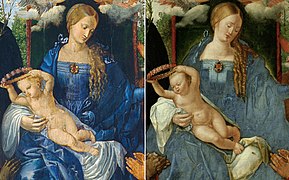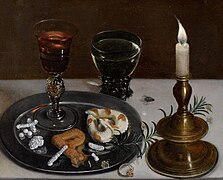
Musca depicta
Musca depicta ("painted fly" in Latin; plural: muscae depictae) is a depiction of a fly as a conspicuous element of various paintings.[1] The feature was widespread in 15th- and 16th-century European paintings, and its presence has been subject to various interpretations by art historians.[1][2]
This article is about painted representations of flies in artworks. For the fly species formerly called Musca picta, see Delphinia picta.Trompe-l'œil fly[edit]
Both Konečný, writing about Dürer's Feast of the Rosary (copy), and Lemeshkin, writing about Skaryna's portrait, observe the flies painted in each do not exactly "sit" on the underlying painted objects, but rather sit above them. Based on this observation, as well as noting the disproportionately large relative size of the flies compared with the other depicted objects, Konečný argues that this was intended as a trompe-l'œil (illusion), that the fly sits on the painting. He also remarks that the fly in the Portrait of a Carthusian (pictured above) serves to intensify the illusion of the trompe-l'œil frame.[5][7] The Portrait of a Carthusian, dated about 1446, is the earliest known example of panel painting with a trompe-l'œil fly.[6]
Trompe-l'œil flies are recognized in over twenty Netherlandish, German, and north Italian paintings dated between 1450 and the 1510s, and are analysed by André Chastel in a book eponymously dedicated to musca depicta.[4][6] Of them, eight are portraits, thirteen are religious miniatures, and only two are large-size works.[6] Chastel remarks that trompe-l'œil flies were a passing fad, with artists later having found other ways to demonstrate their skill.[9]
In popular culture[edit]
The musca depicta is a recurring topic in the 2019 film, The Burnt Orange Heresy. The main character, an art dealer, explains to a woman he meets that it signifies corruption.[10]





